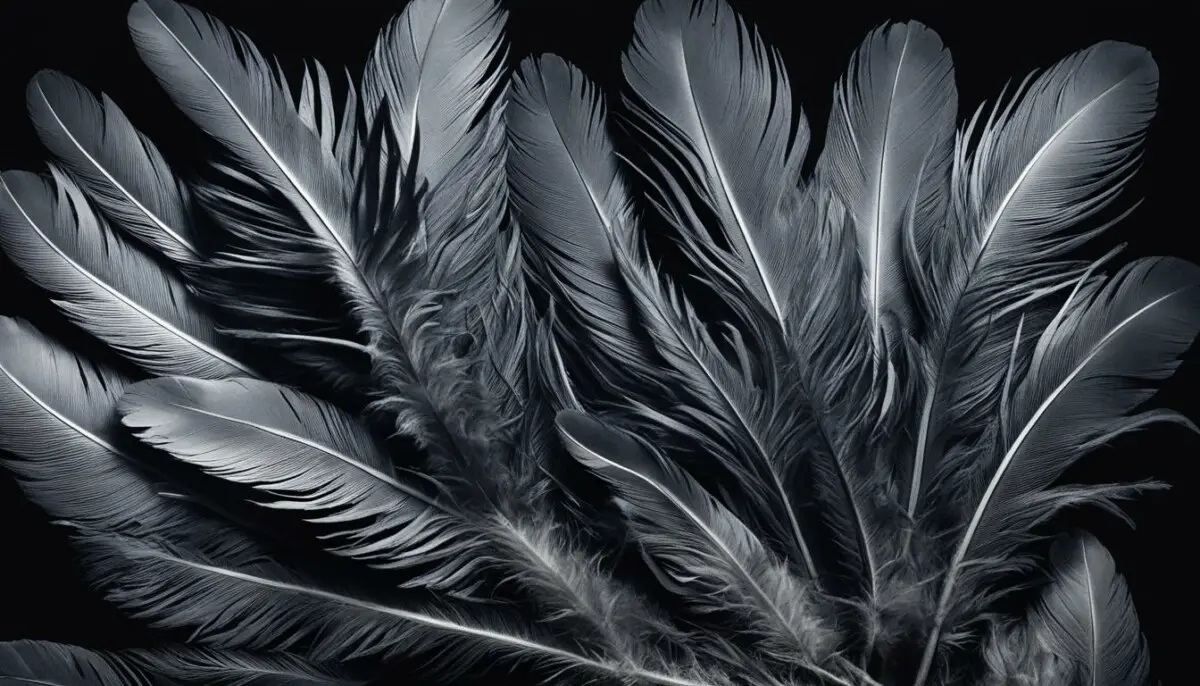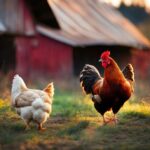Last Updated on 4 months by Francis
When it comes to taking care of our feathered friends, ensuring their safety is of utmost importance. One potential risk that chicken owners should be aware of is the use of infrared lamps. These lamps emit heat, which can lead to burns on chicken feathers and pose fire hazards. It is crucial to understand the dangers associated with infrared lamps and take necessary precautions to protect our chickens and their well-being.
Contents
Key Takeaways:
- Infrared lamps can potentially cause burns on chicken feathers
- Using infrared lamps near poultry can lead to fire hazards
- Ensuring the safety of our chickens is essential
- Understanding the dangers of infrared lamps can help prevent accidents
- Proper precautions should be taken when using heat sources for poultry
The Dangers of Heat Lamps for Poultry
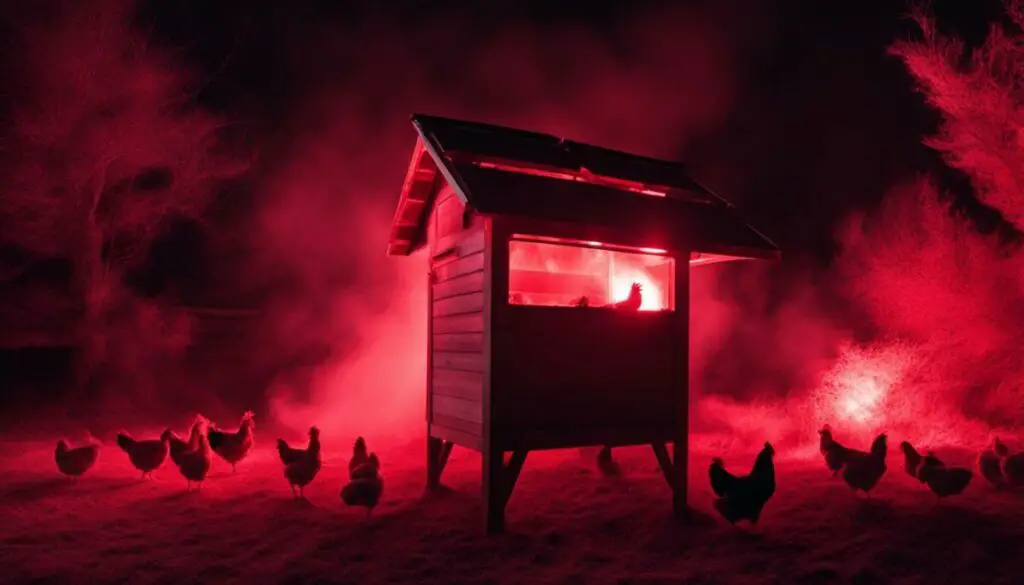
Traditional heat lamps used for brooding poultry can be extremely dangerous. News stories frequently report incidents of injuries, deaths, and property damage caused by heat lamp fires. These incidents can occur due to various factors such as lamps falling, coming into contact with flammable objects, or animals flying into them. Heat lamps are prone to failure and can be a fire hazard even when used carefully.
Heat lamps pose a significant risk to the safety of poultry and their surroundings. The intense heat they emit can easily ignite flammable materials, leading to devastating fires. In fact, a study conducted by the National Fire Protection Association found that heat lamps are a leading cause of barn fires in agricultural settings. The combination of heat, flammable bedding materials, and close proximity to farm structures creates a perfect storm for disaster. It’s crucial for poultry farmers and backyard chicken owners to be aware of these dangers and take appropriate precautions.
When using heat lamps, it’s important to consider the following:
- Ensure the lamp is securely fastened and positioned in a way that prevents accidental tipping or falling.
- Keep the lamp a safe distance away from any flammable materials such as bedding, straw, or dry leaves.
- Regularly inspect the lamp for any signs of wear or damage and promptly replace it if necessary.
- Consider using alternative heating methods, such as radiant heat sources, that pose a lower fire risk.
The Importance of Fire Safety
Fire safety should be a top priority when using heat lamps for poultry. Taking proactive measures to minimize the risk of fires can help ensure the well-being of both the animals and the property. It’s crucial to have smoke detectors, fire extinguishers, and an evacuation plan in place to quickly respond to any potential emergencies.
Educating yourself about the dangers of heat lamps and actively implementing fire safety measures can help protect your poultry, property, and the entire farming community from devastating fire incidents.
The Importance of Proper Brooding for Baby Chicks
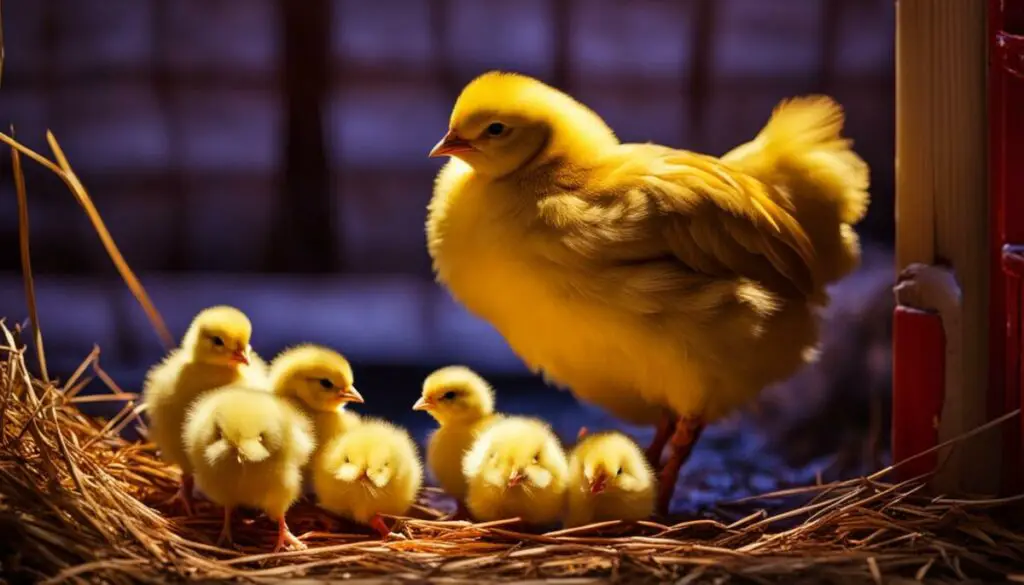
Newly hatched baby chicks are unable to regulate their body temperatures effectively and rely on proper brooding for their well-being. In nature, mother hens instinctively provide warmth to their chicks by keeping them underneath their bodies. This natural heat regulation ensures that the chicks stay at an appropriate temperature and thrive in their early stages of life.
However, when it comes to backyard chicks, relying solely on a traditional heat lamp may not be suitable. Heat lamps can often emit excessive heat, which can be harmful to the delicate baby chicks. Additionally, heat lamps lack individual comfort adjustment, making it difficult to cater to each chick’s specific needs.
Observing mother hens with their babies can provide valuable insights into the ideal temperature requirements for brooding. By studying their behaviors and observing their comfort levels, we can determine the optimal conditions for our baby chicks.
To ensure proper brooding for baby chicks, it is essential to provide them with a safe and comfortable environment that replicates the nurturing warmth of a mother hen. This can be achieved through alternative heat sources that prioritize individual heat regulation and minimize the risk of overheating.
One promising option is the EcoGlow Brooder offered by Brinsea Products. This innovative brooder uses radiant heat to mimic the warmth provided by a hen. The baby chicks can regulate their own comfort levels by moving closer or further away from the brooder plate, just like they would with their mother. The EcoGlow Brooder does not warm the entire brooder space, ensuring that the chicks have a controlled and cozy area without the risk of overheating.
In addition to the EcoGlow Brooder, there are other safe alternatives available that prioritize the well-being of baby chicks during the crucial brooding period. These options include radiant heat plates and other radiant heat sources that provide individual comfort control and reduce the risk of fire hazards.
By prioritizing proper brooding techniques and utilizing safe heat sources, we can ensure that our baby chicks grow up healthy, comfortable, and well-prepared for their future as thriving adult hens.
Comparison of Heat Sources for Baby Chicks
| Heat Source | Advantages | Disadvantages |
|---|---|---|
| EcoGlow Brooder | – Mimics mother hen’s warmth – Individual heat regulation – Reduced risk of overheating – Energy-efficient |
– Initial investment – Limited availability |
| Radiant Heat Plates | – Individual heat regulation – Reduced risk of fire hazards – Easy to clean |
– Initial investment – Requires monitoring of chicks’ behavior |
| Other Radiant Heat Sources | – Individual heat control – Reduced fire risk |
– Different options require careful selection – May have limited availability |
| Traditional Heat Lamp | – Widely available – Lower upfront cost |
– Lack of individual heat control – Increased risk of fire hazards or burns |
The EcoGlow Brooder as an Alternative to Heat Lamps

When it comes to brooding chicks, ensuring their safety and comfort is of utmost importance. Traditional heat lamps have long been used as a heat source, but they come with inherent risks such as fire hazards and the potential for overheating. That’s where the EcoGlow Brooder by Brinsea Products comes in as a reliable alternative.
The EcoGlow Brooder uses radiant heat to replicate the warmth provided by a mother hen. By mimicking natural conditions, chicks can regulate their own comfort levels by moving in and out of the brooder plate.
This innovative brooder design does not warm the entire brooder space, reducing the risk of overheating and the associated dangers. This ensures the safety of your chicks and provides peace of mind for poultry owners concerned about brooder safety.
Compared to traditional heat lamps, the EcoGlow Brooder offers several advantages. Its radiant heat source focuses specifically on the chicks and does not warm the surrounding air, eliminating the risk of fire hazards.
Furthermore, the EcoGlow Brooder is also highly energy-efficient and adjustable, allowing you to customize the warmth to suit your chicks’ needs. This makes it a convenient and cost-effective option for brooding chicks.
With the EcoGlow Brooder, you can provide a safe and comfortable environment for your chicks while minimizing the risks associated with traditional heat lamps. Say goodbye to worrying about fire hazards and overheating, and give your chicks the best start in life with the EcoGlow Brooder.
Benefits of the EcoGlow Brooder:
- Safe alternative to traditional heat lamps
- Uses radiant heat to mimic the warmth of a mother hen
- Chicks can regulate their own comfort levels
- Reduces the risk of overheating and fire hazards
- Energy-efficient and adjustable
Brooding Basics and the Risks of Overheating
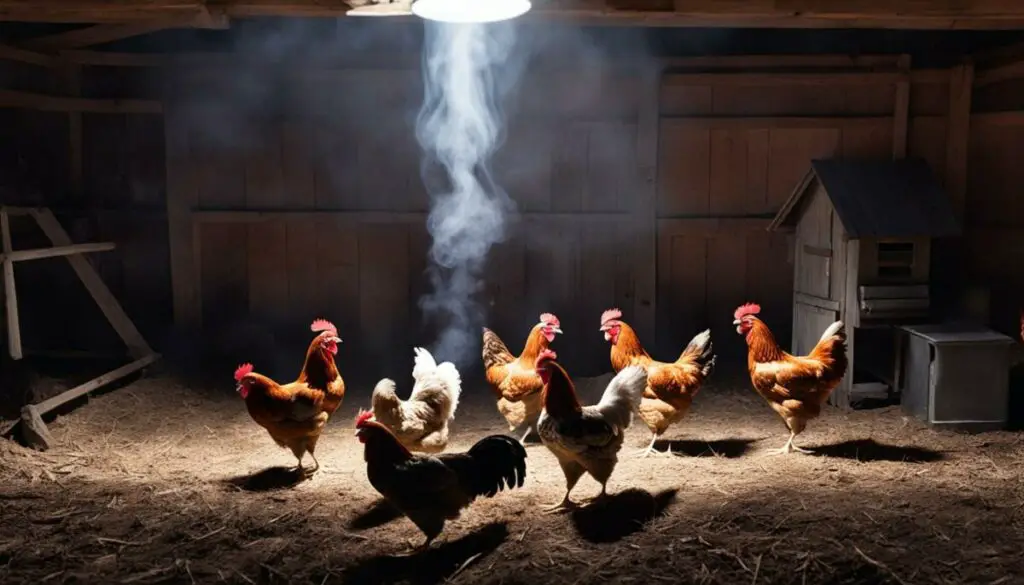
When it comes to brooding baby chicks, understanding the basics is crucial to ensure their well-being. One important aspect of brooding is providing an appropriate ambient temperature for the chicks to thrive. However, it’s essential to be mindful of the potential risks of overheating and its implications, such as pasty butt.
Proper brooding involves creating an environment that allows chicks to regulate their own temperature. While heat lamps are commonly used to provide warmth, they can often warm the entire brooder area, leading to potential overheating. This can pose severe health risks to the chicks, such as pasty butt, a condition where droppings stick to their vents and obstruct their ability to eliminate waste.
To prevent overheating and the associated health issues, it is important to monitor the chicks’ behavior closely. Signs of overheating include panting, holding their wings away from their bodies, or congregating far away from the heat source. On the other hand, if the chicks are huddling together directly under the heat lamp or appear lethargic, it may indicate that they are too cold.
One effective way to ensure even heat distribution and identify any temperature inconsistencies is to use multiple thermometers throughout the brooder. This will help you identify any areas that may be experiencing drafty spots or excessively high temperatures, allowing you to make necessary adjustments.
“Maintaining optimal brooding temperature is crucial for the health and comfort of the chicks. By closely monitoring their behavior and using multiple thermometers, you can ensure a safe and comfortable brooding environment.”
Recommended Brooding Temperature Guidelines
Though brooding temperature requirements may vary slightly depending on the specific breed and age of the chicks, the following general guidelines can be used:
| Age of Chicks | Temperature |
|---|---|
| 0 – 7 days | 95°F – 100°F |
| 8 – 14 days | 90°F – 95°F |
| 15 – 21 days | 85°F – 90°F |
| 22 – 28 days | 80°F – 85°F |
As the chicks mature, they gradually develop their ability to regulate body temperature and become less dependent on supplemental heat. It’s essential to gradually reduce the brooding temperature to mimic natural conditions and encourage their independence.
By following proper brooding basics and monitoring the ambient temperature carefully, you can minimize the risks of overheating and ensure the health and well-being of your baby chicks.
Choosing the Right Heat Source for Brooding

When it comes to brooding, selecting the right heat source is crucial for the safety and comfort of your chicks. While traditional incandescent bulbs and infrared bulbs have been commonly used, they come with certain risks, such as fire hazards and disruptive light. Consider alternatives like radiant heat sources that provide a safer and more efficient solution.
Radiant heat sources, such as the EcoGlow brooder or ceramic bulbs, offer several advantages. Unlike traditional heat lamps, which primarily heat the air, radiant heat sources directly heat objects. This focused heat transfer ensures a more natural and comfortable environment for your chicks. Additionally, radiant heat sources significantly reduce the risk of fire incidents, making them a safer choice.
One popular option is the EcoGlow brooder, offered by Brinsea Products. This innovative brooder uses radiant heat to mimic the warmth provided by a mother hen. The chicks can regulate their own comfort levels by freely moving in and out of the brooder plate, just like they would under a hen’s wings. The EcoGlow brooder not only enhances safety but also promotes natural behavior and development.
Another alternative is ceramic bulbs, which emit radiant heat without the disruptive light associated with traditional bulbs. These bulbs are energy-efficient and provide a comfortable infrared heat that mimics the warmth of the sun. Ceramic bulbs are a popular choice among poultry owners who prioritize the well-being and safety of their flock.
By selecting a radiant heat source, you can ensure a safer and more efficient brooding environment for your chicks, reducing the risks associated with traditional heat lamps. From the EcoGlow brooder to ceramic bulbs, these alternatives offer a more natural and comfortable heat source, enhancing the well-being of your flock.
Understanding the Effects of Continuous Light on Chickens
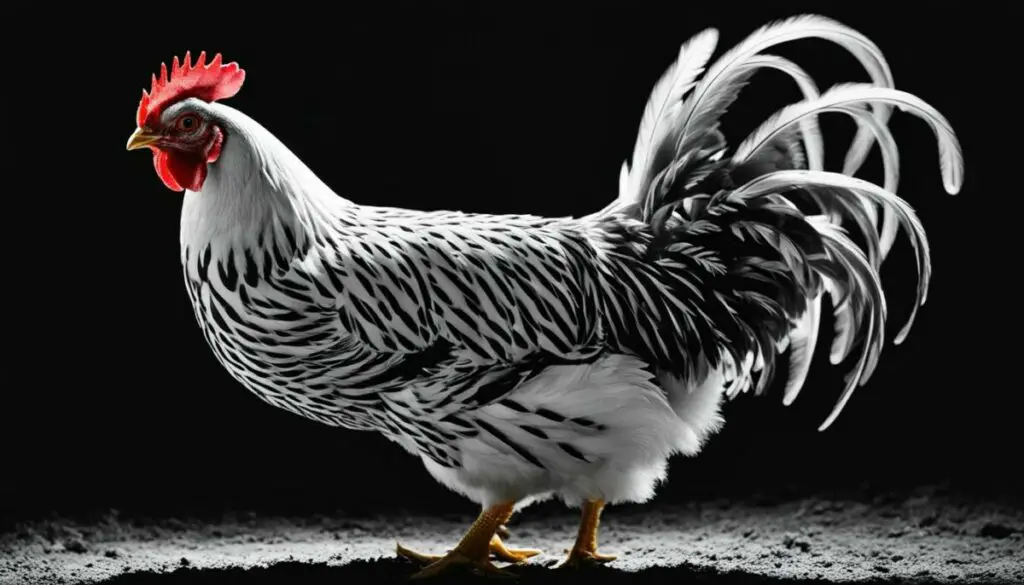
Continuous light exposure, such as having a heat lamp on all night, can have detrimental effects on chickens. Studies have shown that continuous light can cause permanent eye damage and increase aggression and feather pecking behavior.
Chickens are naturally diurnal creatures, and extended exposure to artificial light disrupts their natural behavioral patterns. This disruption can lead to various health issues, including light-induced avian glaucoma, a condition characterized by increased pressure within the eye, potentially leading to blindness.
It is crucial to consider the negative impacts of continuous light when providing heat to chickens. While red heat lamp bulbs are often used to simulate day/night rhythms, they may worsen eye problems due to their intensity. Alternatives that minimize light exposure should be explored to ensure the well-being of the chickens.
To illustrate the harmful effects of continuous light on chicken health, refer to the following table:
| Effects of Continuous Light on Chickens | Description |
|---|---|
| Eye Damage | Continuous light exposure can lead to permanent eye damage, including light-induced avian glaucoma. |
| Aggression | Chickens exposed to continuous light may exhibit increased aggression towards other flock members. |
| Feather Pecking Behavior | Continuous light can also contribute to feather pecking behavior, causing harm to the chicken’s plumage. |
By understanding these negative impacts, it becomes evident that alternatives to continuous light should be considered to promote the health and well-being of chickens.
Safe Lighting Alternatives for Chickens
To provide heat for chickens without subjecting them to continuous light exposure, consider the following options:
- Radiant Heat Sources: Radiant heat plates or ceramic bulbs provide localized warmth without the need for constant light.
- Timers: Use timers to control the duration of light exposure and ensure adequate periods of darkness for natural rest.
- Natural Light: Allow chickens access to natural daylight, which offers a better balance of illumination compared to artificial light.
Implementing these safer alternatives will help minimize the negative effects of continuous light on chicken health, ensuring their comfort and overall well-being.
Do Chickens Need Heat in Winter?
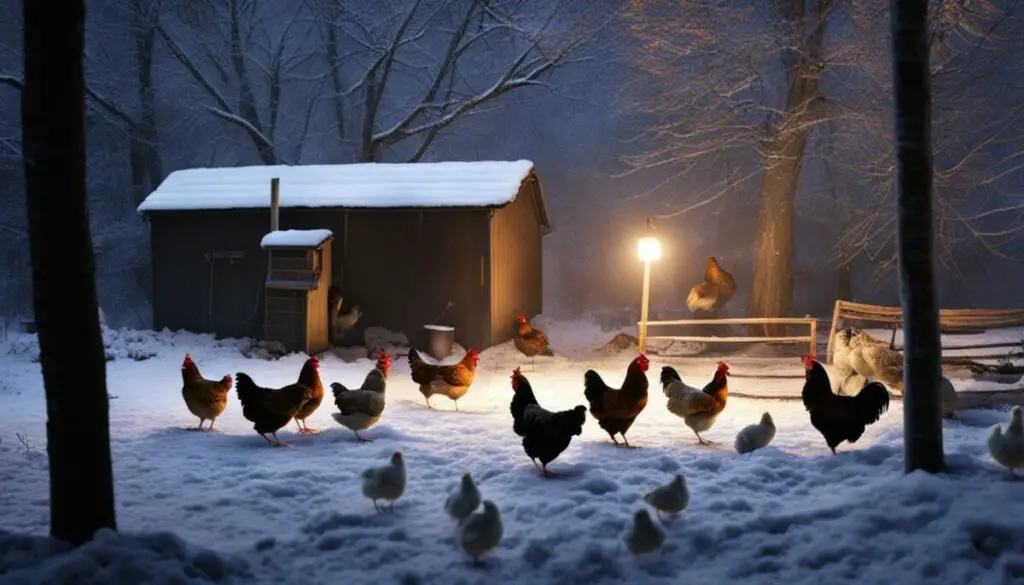
The winter season brings colder temperatures, which raises the question: do chickens need additional heat to stay comfortable and healthy during this time? The answer depends on various factors such as the breed of chickens, their age, and the climate in which they are raised.
Chickens have been selectively bred for cold tolerance, and many breeds are more resilient to lower temperatures than their ancestors. They are equipped with features such as down feathers and the ability to fluff up their feathers to trap warm air and regulate their body temperature. Hardy breeds like Rhode Island Reds, Plymouth Rocks, and Orpingtons have better cold tolerance and can withstand the winter chill better than others.
Proper coop design also plays a crucial role in keeping chickens warm during winter. A well-insulated coop with good ventilation can help retain heat and prevent drafts. Coop windows should be covered with insulating materials to reduce heat loss at night while allowing natural light during the day.
However, extreme cold weather conditions or less cold-tolerant breeds may require supplemental heat for the well-being of the chickens. It is essential to monitor the temperature inside the coop and observe the behavior of the chickens to determine if they are too cold. Signs of discomfort or stress include huddling together, shivering, reduced activity, or decreased egg production.
If additional heat is necessary, there are safe and effective options available. One popular choice is the use of radiant heat plates or panels. These devices provide gentle heat from below, mimicking the warmth provided by a mother hen, without the risk of fire hazards associated with traditional heat lamps. Radiant heat plates are designed to be low wattage, energy-efficient, and can be adjusted to meet the specific needs of the chickens.
Remember, it is crucial not to overheat the coop as it can lead to other health issues. Maintaining the right balance is key, ensuring the chickens are warm enough while avoiding excessive heat and humidity, which can cause respiratory problems or promote the growth of harmful bacteria.
Here are some tips to support the chickens’ well-being during winter:
- Ensure the coop is draft-free and well-insulated.
- Use insulating materials to cover coop windows at night.
- Monitor the temperature inside the coop regularly.
- Observe the chickens’ behavior for signs of discomfort.
- Consider using radiant heat plates if additional heat is necessary.
- Avoid overheating the coop and maintain proper ventilation.
By understanding the specific needs of your chickens and taking the necessary precautions, you can provide them with a safe and comfortable environment during the winter months.
Safe Heating Options for Chicken Coops
When it comes to providing supplemental heat for chicken coops, it is crucial to prioritize safety. By choosing the right heating options and implementing necessary safety precautions, you can ensure the well-being of your chickens while minimizing the risk of fire and other hazards.
Radiant Heat Plates
Radiant heat plates are a safe and efficient option for providing supplemental heat in chicken coops. These plates hang above the roosting area, emitting gentle warmth that mimics the heat provided by a mother hen. The radiant heat plates are designed to allow chickens to regulate their own comfort levels by moving closer to or farther away from the heat source.
Oil-Filled Radiators
For larger chicken coops, oil-filled radiators with tilt shut-off features are a reliable choice. These radiators provide consistent heat distribution and offer added safety measures. The tilt shut-off feature automatically turns off the radiator if it tips over, reducing the risk of fire accidents.
Ceramic Bulbs
Another safe option for supplemental heat in chicken coops is ceramic bulbs. These bulbs emit heat without producing disruptive light, creating a comfortable environment for the chickens. Ceramic bulbs are known for their energy efficiency and longevity, making them a cost-effective choice for chicken owners.
Safety Precautions
Regardless of the heating option chosen, it is essential to follow safety precautions to protect both your chickens and the coop. Here are some safety measures to consider:
- Ensure all electrical equipment is securely installed and out of reach of chickens or potential pests.
- Regularly inspect all heat sources for any signs of damage or malfunctioning.
- Keep the coop clean and free from flammable materials.
- Monitor the temperature regularly and adjust the heat source accordingly to maintain a safe and comfortable environment.
- Have a fire extinguisher nearby in case of emergencies.
By implementing these safety precautions and choosing the right heating options, you can provide supplemental heat to your chicken coop without compromising the safety and well-being of your feathered friends.
Conclusion
Proper brooding and heating practices are crucial for ensuring the well-being of chickens, particularly during winter and brooding periods. Heat lamps, although commonly used, come with risks such as fire hazards and eye damage. Fortunately, there are alternative heating options that provide a safer and more efficient solution – radiant heat sources.
Understanding the specific needs of chickens is essential for their safety and comfort. By observing their behavior, we can ensure that their heating requirements are met adequately. Choosing appropriate heating options, such as radiant heat sources like the EcoGlow Brooder or ceramic bulbs, can support optimum brooding safety.
Whether it’s providing warmth during winter or creating a safe brooding environment, radiant heat sources offer superior advantages. They mimic the natural warmth provided by mother hens and allow chicks to regulate their own comfort levels. In addition, radiant heat sources, such as the EcoGlow Brooder, minimize the risk of overheating or fire hazards, providing peace of mind for poultry owners.
By prioritizing brooding safety and utilizing radiant heat sources, chicken owners can create a comfortable and secure environment for their feathered friends. With the right heating practices in place, chickens can thrive throughout winter and brooding periods, while minimizing risks and ensuring their overall well-being.
FAQ
Can an infrared lamp burn chicken feathers?
Yes, an infrared lamp can potentially burn chicken feathers as it emits heat. It is important to be cautious when using infrared lamps near poultry to avoid burns or fire hazards.
Are heat lamps dangerous for poultry?
Yes, heat lamps can be extremely dangerous for poultry. They pose a fire hazard and can cause injuries, deaths, and property damage. It is important to be aware of the risks associated with heat lamps and take precautions to ensure safety.
How can I provide proper brooding for baby chicks?
Baby chicks require proper brooding for their well-being. Observing the behavior of mother hens can provide insights into the appropriate temperature requirements. Options like the EcoGlow Brooder can offer a safer alternative to traditional heat lamps, providing radiant heat and allowing chicks to regulate their own comfort levels.
What are the risks of overheating during brooding?
Overheating can pose health issues for chicks, such as pasty butt. It is important to provide enough space for them to regulate their own temperature and monitor their behavior. Multiple thermometers can be used to ensure even heat distribution and identify any drafty spots in the brooder.
What is the best heat source for brooding?
Options like incandescent bulbs, infrared bulbs, and radiant heat sources are available for brooding. Traditional heat lamps pose risks such as fire hazards and disruptive light. Radiant heat sources, like the EcoGlow Brooder or ceramic bulbs, provide a safer alternative as they heat objects instead of the air and have lower risks of fire incidents.
What are the effects of continuous light on chickens?
Continuous light exposure can cause permanent eye damage, increase aggression, and trigger feather pecking behavior in chickens. Red heat lamp bulbs, often used to simulate day/night rhythms, may worsen eye problems. It is important to understand the negative impacts of continuous light and consider alternative and safer methods for providing heat to chickens.
Do chickens need supplemental heat in winter?
The need for supplemental heat in winter depends on various factors, such as breed, age, and climate. Hardy breeds and well-designed coops can often handle winter temperatures without additional heat. However, extreme cold or less cold-tolerant breeds may require some form of supplemental heat for their well-being.
What are safe heating options for chicken coops?
Safe options for providing supplemental heat in chicken coops include radiant heat plates, oil-filled radiators with tilt shut-off features for larger coops, and ceramic bulbs. It is crucial to ensure that all electrical equipment is secure and away from chickens or potential pests to minimize the risk of fire and other hazards.
How can I ensure the safety of my chickens during winter and brooding?
Proper brooding and heating practices are essential for the well-being of chickens. Understanding the risks associated with heat lamps, observing the behavior of chicks, and choosing appropriate heating options, such as radiant heat sources, can help ensure their safety and comfort during winter and brooding periods.

